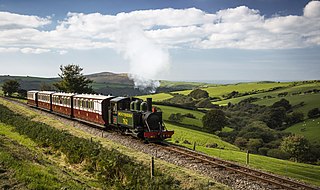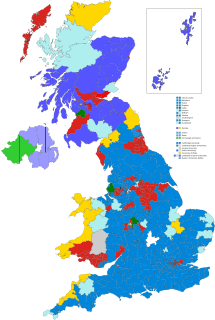Related Research Articles

Barnstaple is a river-port town in North Devon, England, at the River Taw's lowest crossing point before the Bristol Channel. From the 14th century, it was licensed to export wool and won great wealth. Later it imported Irish wool, but its harbour silted up and other trades developed such as shipbuilding, foundries and sawmills. A Victorian market building survives, with a high glass and timber roof on iron columns. The parish population was 24,033 at the 2011 census, and that of the built-up area 32,411 in 2018. The town area with nearby settlements such as Bishop's Tawton, Fremington and Landkey, had a 2020 population of 46,619.

The Lynton & Barnstaple Railway (L&B) opened as an independent railway in May 1898. It was a single track, 1 ft 11+1⁄2 in narrow gauge railway and was slightly over 19 miles (31 km) long running through the rugged and picturesque area bordering Exmoor in North Devon, England. Although opened after the 1896 Light Railways Act came into force, it was authorised and constructed prior to that act. Therefore, as with all other railways, it was authorised under its own Act of Parliament and built to higher standards than similar railways of the time. In the United Kingdom it was notable as being the only narrow gauge line required to use main-line standard signalling. For a short period the line earned a modest return for shareholders, but for most of its life the L&B made a loss. In 1923 the L&B was taken over by the Southern Railway, and eventually closed in September 1935.
The Braunton Road railway accident occurred on 1 January 1910 in England. The Lynton & Barnstaple Railway maintained an exemplary safety record throughout its short existence from 1898 to 1935, with no passenger or member of the public having ever been injured or killed.

Barnstaple was a constituency centred on the town of Barnstaple in Devon, in the South West of England. It returned two Members of Parliament to the House of Commons of the Parliament of the United Kingdom until 1885, thereafter, one.
Ralph was Archdeacon of Barnstaple until 1143.
William de Auco was Archdeacon of Barnstaple until 1155.
Roger was the fourth Archdeacon of Barnstaple.
Thomas was Archdeacon of Barnstaple until 1203.
John was the seventh Archdeacon of Barnstaple, England.
Isaac was the Archdeacon of Barnstaple until 1227.
Walter de Pembroke was the ninth Archdeacon of Barnstaple.
Thomas de Hertford was Archdeacon of Barnstaple until 1271 and also Archdeacon of Totnes from 1270 to 1275.
Philip of Exon was Archdeacon of Barnstaple until 1279.
Ralph Germeyn was Archdeacon of Barnstaple until 1308.
John Pollard was a 16th-century Archdeacon of Wiltshire, Archdeacon of Cornwall, Archdeacon of Barnstaple and Archdeacon of Totnes.
Henry Squire was Archdeacon of Barnstaple from 1554 to 1582.
Robert Lawe was Archdeacon of Barnstaple from 1582 to 1585.
Thomas Lynford was Archdeacon of Barnstaple.
Lewis Stephens was Archdeacon of Barnstaple and Archdeacon of Chester.
Ralph was an Archdeacon of Barnstaple during the early part of the Thirteenth century.
References
- ↑ Exeter Time Trail
- ↑ "Memorials of Barnstaple; being an attempt to supply the want of a history of that ancient borough" Gribble, J.B: Barnstaple, J.Avery, 1830